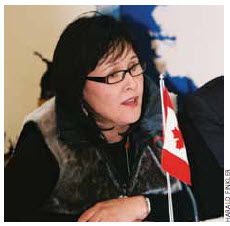
By Laura Neilson Bonikowsky
The Arctic is a stable region of eight nations that generally exhibit mutual trust and co-operation. The key body concerned with the dialogue among these states is the Arctic Council, whose members include, in addition to the eight Arctic nations (Canada, U.S., Denmark, Norway, Finland, Sweden, Russia and Iceland), permanent participants and observers that are not Arctic nations, but nevertheless have an interest in the Arctic. The role of the Arctic Council is to facilitate ongoing co-operation between Arctic states in the debate over who owns and controls which parts of the Arctic. That debate excludes security but includes environmental monitoring and the creation of common standards for shipping and oil and gas development.
Ownership of the Arctic is mainly determined by geography, scientific data, domestic law and international law as defined by the UN Convention on the Law of the Sea (UNCLOS). All Arctic nations but the United States have ratified UNCLOS and several others — China, India, Japan and South Korea — are also UNCLOS signatories, but have no role in the Arctic Council and mainly economic interest in the region. The region is contentiously open to claims from non-Arctic countries; China’s unofficial position, relayed by Chinese Rear Admiral Yin Zhuo, is that the “Arctic belongs to all the people around the world as no nation has sovereignty over it.”
Among the parameters defined by UNCLOS are marine boundaries within which nations have economic rights over water and seabed resources. This exclusive economic zone (EEZ) stretches 200 nautical miles (370 km) from the nation’s coastline; most energy development will take place within this zone. Adjacent states may disagree over maritime borders, particularly where they overlap geographically. Canada and the U.S. disagree over their boundary in the Beaufort Sea, and Norway and Russia had a 40-year dispute over a boundary in the Barents Sea that was settled in 2010.
Beyond the EEZ, nations may exert ownership of seabed resources on its extended continental shelf, up to 350 nautical miles (650 km). Establishing the limits of the continental shelf depends on geological and geomorphological characteristics, which may require expensive and extensive data collection. Nations have 10 years to make submissions to the Commission on the Limits of the Continental Shelf (CLCS), which facilitates the implementation of UNCLOS with regard to establishing the limits of the continental shelf.
In the case of boundary disputes, the parties must negotiate with each other while CLCS may play an advisory role. Among current disputes over Arctic boundaries is the Northwest Passage, which Canada maintains is within its internal waters. The U.S. and other nations dispute the claim. The United Kingdom considers both the Northwest Passage and the Northern Sea Route, which is claimed by Russia, as existing within international waters.
In addition to determining sovereignty and ownership, international regulations must be established. Maritime traffic through the Arctic, already considerable, is a major interest among Arctic and non-Arctic nations. The Northern Sea Route has already seen transits by supertankers such as the Japanese Sanko Odyssey, which in 2011 completed a trip from Russia’s Kola Peninsula to Jingtang in China. Such trips save weeks and thousands of kilometres of sailing. It must be noted that climate change could negate UNCLOS provisions concerning ice-covered waters and initiate challenges to coastal states’ legal rights to regulate shipping.
Arctic energy resources have become hot political topics, their development politically controversial on environmental grounds. As the Arctic economy becomes integrated into the global economy, its geopolitical relevance will increase. Within Arctic nations, exploration and development, federal politics, indigenous populations, economic prosperity, sustainability and the environment all play a role. The key geopolitical dimension to developing Arctic oil and gas involves power, stability and influence between the Arctic states and with non-Arctic stakeholders, such as China, whose expanding oil and gas imports from Russia have become an important policy objective for the Russian government. Investment in the Arctic is becoming increasingly international.
In 2008, a separate caucus appeared to emerge within the Arctic Council, made up of the five coastal states (known as the A-5, they are: Canada, Denmark/Greenland, Norway, Russia and the U.S.) More significantly, the council is discussing criteria to be applied to permanent observers; these criteria were established in 2011 following disagreements between the Arctic states about how to address applications from non-Arctic states, including the European Union and China. A decision is expected in the spring of 2013.
Although Arctic governance lies principally with the eight Arctic nations, their domestic concerns, associations with economic partners and security agencies, and international agreements affect their perspectives and their abilities to shape Arctic policy.
Laura Neilson Bonikowsky is an Alberta writer. Reach her at lnbonikowsky@shaw.ca





